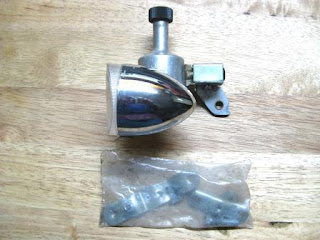I confess: I bought it because I had one like it in my youth. And the price was right.
It's a German-made Union "bloc" generator, on which the headlight is attached. Generators of this type are made to mount on the front fork. This one was most likely made during the mid-1970's. I tested it, and found its light output to be surprisingly good, given the light's small size and old-style bulb.
The best-known generator of this style was made by Soubitez of France. It--especially in its later iterations--was very stylish, as Soubitez products tended to be, and lighter in weight than other generators.
However, the light on this one is larger than the one on its Soubitez counterpart. It is also, as you can see, mounted on the side of the generator, while Soubitez's light was mounted on the front of the generator body. (Sanyo and other companies emulated Soubitez in this detail.)
Some would argue that the Union was a somewhat more efficient generator. Having owned both, as well as other generator sets made by both companies, I would say they were about equal in that regard.
French constructeurs commonly installed Soubitez generators (on brazed-on brackets) and lights on their touring bikes and randonneuses, while many Dutch and German city bikes were equipped with Union products.
I was going to use the Union bloc generator in the photo on Marianela. However, the strut from the basket got in the way.
That's too bad, because I think it would have looked right on the bike. And it's a good generator. The light is good, too, especially considering that it's an older technology. Perhaps there's a halogen or LED bulb that would fit.
Some would say that would violate the "spirit" of having a light like this. But I'm all for new technology (when it works better than the old) with old style. And, for me, that would have been the point of using it.
Although the day was almost as mild as yesterday was, I didn't ride. In fact, I barely got out of my apartment at all. I wasn't the only one who stayed indoors: The driving rain that began some time early this morning seemed not to let up.
As much as many of us would like to think Spring has sprung, some things tell us otherwise:
Stretching toward the light of a sun that is beyond them, their wizened fingers must weather the wind and rain, for now. They remind me of what Robert Browning wrote in Andrea del Sarto: "Ah, but a man's reach should exceed his grasp/Or what's heaven for? All is silver-grey/Placid and perfect with my art: the worse!
A warm, or at least mild, early March day. And I spent a good part of it doing errands. At least it was on my bike.
Is a day like this one a foreshadowing of the season that will soon come? Or is it a respite from the long, wearying season we've been experiencing? Or is it just a teaser?
What if days like this were labeled? What if bikes were so labeled? Some announce themselves as racing bikes, city bikes or "comfort tourers" (whatever they are) in the decals on their frames or other parts. Nearly all bikes--even the ones that aren't so marked--are marketed under one designation or another.
What if there were truth in advertising? One bike might be labeled, "sound design, solid construction." Another would have to say, "Ignores 140 years of accumulated wisdom." Yet another would have to say, "Designed by art-school dropout on crystal meth."
Or they could tell you what they offer. "Arcane design and proprietary parts." How would you like a bike that so announced itself? "Plastic with a pretentious name." Then there are those bikes that could tell us they offer a "comfortable ride," "speed" or, perhaps, "flawless shifting and braking." They could take their inspiration from this:
That building is in my neighborhood, more or less. I've always wondered whether "Cornice and Skylights" was an advertisement? An announcement? The name of the firm that built or manages it?
Whatever its story, it has nothing on this building on the eastern end of Long Island:
You guessed it: Ducks and duck eggs were sold inside this building by a duck farmer. (Now there's a career!) Now it's a museum or visitors' center or some such thing. I'm not surprised, as the days when one could make, or order in a restaurant, a dinner consisting of duck, potatoes and vegetables from Long Island are long past. (Such a dinner could be had during my childhood. The ingredients could even be bought at our neighborhood's Waldbaum supermarket.)
Hmm...Can you imagine a bike shop or factory shaped like the product made or sold inside? Is that Bauhausian? Or some other -ian? Or Ian?




